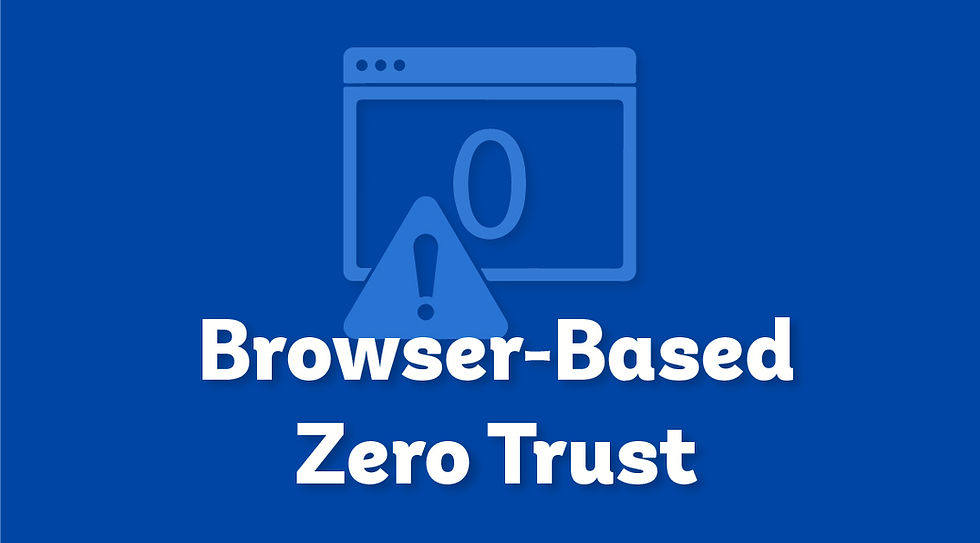Why Zero Trust Architecture Is Key to Cybersecurity in 2025
- bakhshishsingh
- Aug 5, 2025
- 2 min read
Traditional Security Is Dead. Here’s Why You Need Zero Trust Architecture Now
In an age where cyberattacks can originate from anywhere—inside or outside your network—relying on traditional perimeter-based security is no longer enough. Zero Trust Architecture (ZTA) has emerged as the new standard for protecting digital assets, systems, and users.
Zero Trust assumes one thing above all else: never trust, always verify. Whether the user is inside the network or accessing remotely, continuous authentication and strict access control are enforced at all times.
What Is Zero Trust Architecture?

Zero Trust Architecture is a security framework that requires every user and device to be verified continuously, regardless of their location. Access is granted only after thorough authentication, authorization, and behavioral validation.
Unlike older models that trusted internal users by default, Zero Trust treats every attempt to access resources as potentially hostile—even from within the network.
Key Principles of Zero Trust

To build an effective Zero Trust model, your organization must adopt the following core principles:
Least Privilege Access
Grant users the minimum permissions they need to perform their roles. No unnecessary access.
Micro-Segmentation
Divide your network into smaller, secure zones to isolate resources and contain breaches.
Multi-Factor Authentication (MFA)
Use two or more authentication methods (e.g., password + OTP) to validate users before access.
Continuous Monitoring and Validation
Track all user activity and device behavior in real time. Alert on anomalies, enforce session controls.
Assume Breach
Always act as though a breach is either underway or imminent. Focus on limiting blast radius and speeding up detection.
Implementing Zero Trust: A Step-by-Step Approach

Assess and Map Your Network
Identify all users, devices, applications, and data flows. Know your assets before securing them.
Define Access Policies
Set rules for who can access what, when, and how—based on roles, behavior, and risk.
Deploy Advanced Authentication
Enforce MFA, strong password policies, and context-aware login methods.
Segment Your Network
Use micro-segmentation to isolate workloads and limit lateral movement in case of breach.
Implement Continuous Monitoring
Invest in tools that offer real-time threat detection, automated response, and comprehensive logging.
Why Zero Trust Matters More Than Ever
Remote Work & BYOD: Employees and contractors now work from everywhere. Zero Trust keeps your systems secure without relying on location-based access.
Cloud Adoption: Applications and data no longer live in a centralized environment. Zero Trust follows users and data across hybrid and multi-cloud setups.
Evolving Threat Landscape: With insider threats, ransomware, and supply chain attacks rising, Zero Trust provides resilience and adaptability.
Zero Trust = Smart Business Security
Adopting Zero Trust isn't just about protection—it's about enabling secure digital transformation. Organizations that implement ZTA:
✅ Reduce breach risks✅ Improve compliance posture✅ Boost customer and stakeholder confidence✅ Future-proof their cybersecurity strategy
Ready to Build a Zero Trust Foundation?
At Allendevaux, we help businesses design and deploy Zero Trust Architecture tailored to their operations and risk profile.
Our services include:
Zero Trust readiness assessments
Network segmentation planning
Identity and access management (IAM) integration
Continuous monitoring deployment
📧 info@allendevaux.com📞 US: +1 617 344 9290 | UK: +44 1628 274846🌐 www.allendevaux.com
Conclusion: Don’t Wait to Trust Zero Trust
In cybersecurity, assuming safety is the most dangerous move you can make. With Zero Trust, your organization takes control—proactively defending against modern threats with intelligence, agility, and confidence.




Comments